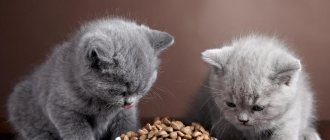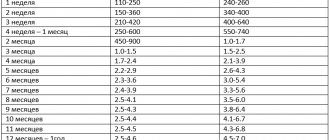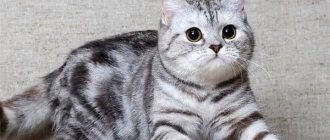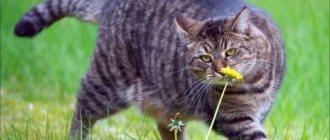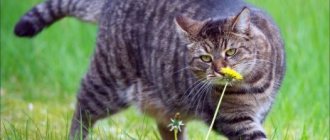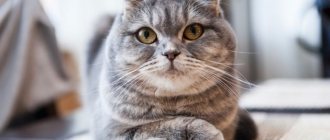A caring owner is always interested in whether his pet is developing correctly. In order to notice alarming trends in time, it is necessary to track the weight of the Scottish kitten by month.
It is important that the Scottish cat’s food is balanced and served in accordance with the regimen. Obesity not only spoils the pet's appearance, but is also dangerous to the animal's health in all aspects. Your Scottish Straight or Fold will live a long and happy life if treated well and with care.
The rate of weight gain in the first days of life
At this time, development occurs very quickly, every week the cubs weigh 10-20 grams more. The first month of life, kittens are helpless and do not leave their mother for long, feeding on her milk.
Up to two weeks, babies are blind and move little, actively gaining weight, which during this period is about 440 grams. Little cats begin to explore space and learn to control their bodies.
Proper development also depends on how the nursing cat eats. Buy high-quality food intended for the animal at a given period of life. The weight of a Scottish cat by month is 400-600 grams.
Scots size
An adult Scottish cat should reach a size of 55 cm. The length of the entire body is measured without taking into account the tail. The length of the tail of Scottish Fold cats should be no less than the distance from the shoulder blades to the tailbone. The height of cats from floor to withers is about 30 cm.
If your cat is not growing, it may be that she has a skeletal abnormality or is simply naturally small. The reason why some parents give birth to babies of different sizes lies in their genetic inheritance.
Did you like the article? Rate it and tell your friends!
While the kitten is growing, it is important to monitor its weight gain. This will allow you not to miss possible deviations in the baby’s development or health problems with his mother.
A table that shows the development norms of this breed depending on the age and gender of the pet will help you control the weight of a Scottish kitten by month.
3-6 months
You can determine how much your pet weighs using kitchen scales and later floor scales. By the age of four months, Scots weigh about 2 kilos. These are independent, active animals that need sufficient calories and vitamins. They are actively growing.
What weight category a pet occupies depends on its genetic predisposition and quality of nutrition. The owner needs to decide whether to give the baby ready-made food or prefer natural food from products that should be prepared separately for the pet without salt and spices.
What to do if your weight is not normal
If underweight or overweight does not exceed 200 grams, then there is no reason to worry; most likely, the pet simply overate a little or did not move much. But if there is a large deviation from the norm, you need to contact a veterinarian, who will determine the cause and, if necessary, prescribe a course of treatment.
If your weight is below normal
If your Scottish Fold cat's weight at any stage of its growth is significantly below normal, you need to take your pet to a veterinarian. If the animal does not have problems with the gastrointestinal tract, the specialist will prescribe vitamins and give recommendations on changing the diet.
If your weight is higher than normal
Excess weight in a cat often causes the development of serious diseases, so the owner needs to monitor the diet and try not to overfeed the pet. If your pet is already overweight, you should review its diet and gradually reduce the portion size.
You will also have to take care of physical activity - you need to play with the cat more often to burn extra calories.
Weight gain chart
Scottish kitten weight table by month
| Age | Female weight (kg) | Male weight (kg) |
| 1 month | 0,3-0,6 | 0,45-0,7 |
| 2 months | 0,45-0,76 | 0,85-1,6 |
| 3 months | 1,25-1,65 | 1,35-2,4 |
| 4 months | 1,74-2,35 | 2-3,7 |
| 5 months | 2,25-3,1 | 2,45-4,19 |
| 6 months | 2,36-3,57 | 3-5,56 |
| 8 months | 2,9-4,26 | 3,45-6 |
| 10 months | 3,1-4,63 | 4,2-7,1 |
| 1 year | 3,2-5,35 | 4,6-7,35 |
| 2 years | 3,42-5,65 | 5,4-8,1 |
Thus, the weight table for Scottish kittens shows the approximate rate of weight gain. A kitten at 2 months is approaching 1 kg, while a Scottish kitten at 3 months weighs about one and a half. During this period, their appetite is very good, babies eat everything offered and wash it down with mother's milk.
Kitten weight table by month
For clarity, below is a table with detailed information on how the indicators for the Scottish fold change.
| Age | Cat, g | Cat, g |
| Newborn | 70-145 | 60-140 |
| 2 weeks | 340-420 | 140-360 |
| 1 month | 400-720 | 240-600 |
| 3 months | 1500-2500 | 1000-1500 |
| 6 months | 3000-5400 | 2300-3600 |
| 8 months | 3500-6000 | 2500-4200 |
| 10 months | 4100-6700 | 2500-4500 |
| 1 year | 4500-7000 | 2500-4800 |
The table shows that Scottish Fold and Straight cats gain weight unevenly. In the first weeks of life, the indicators increase very quickly, since at this time the animal is actively growing. The older the pet, the more stable its weight and size become.
Important! If a cat weighs about 5 kilograms at 1 year, over the next year he can lose 500-800 grams, and this is normal. But if your pet has lost more than 1.5-2 kilograms, you need to contact a veterinarian.
How old do Scottish cats grow?
Scottish Fold cats, like straight-eared ones, become teenagers at 4-6 months. By this time, the females begin to estrus, and the males become eligible bachelors. At the age of more than a year, an adult gains no more than 500-700 grams up to 2.5 years.
How long your pet will gain weight is determined by its health, tendency to overeat, and mobility. But when answering the question, to what age do cats grow, we can answer unequivocally that at 2.5 years growth stops.
You can determine the age of a Scottish Fold cat by human standards by multiplying the number of cat years by 7.
Newborn kitten weight
A newborn kitten should weigh in the range of 60-140 grams, and if the indicators differ greatly from the norm, this may indicate health problems. Then the baby will need more careful care.
The worst thing is when the pet is underweight - feeding such kittens is the most difficult.
Important! Caring for Scottish cats during pregnancy directly affects the health of the offspring. If she ate well and did not get sick, this significantly increases the chances of having healthy babies.
Growth and development of cats of different breeds
Kittens develop exactly to the parameters dictated by their breed:
- 1. British. Kittens grow big. British adults continue to grow up until they are three years old. Puberty occurs at the age of 9 months. The weight reaches up to eight kilograms, and for castrati it is even more.
- 2. Scottish. One of the most popular and sought after breeds in the world. Representatives of this breed are either lop-eared or straight-eared. Scots reach their final size by the age of three.
- 3. Bengal. One of the large cat breeds. It reaches its peak growth by one year. It grows to its final size by two years. In childhood it is characterized by slow growth.
- 4. Maine Coons. Kittens are already born large. Birth weight ranges from 120 to 170 grams. By five months there is a significant increase in growth. During this period, the Maine Coon develops inharmoniously. That is, one part of the body grows larger than the other. Growth stops by age three. Such a cat can grow up to one meter.
- 5. Siberian. They grow to medium size. They usually reach a weight of 4 to 5 kg. Growth continues for up to one and a half years.
- 6. Sphinxes. Hairless breed of medium size. Normal weight is about 4 kg. Sexual maturity occurs at 12 months. Growth continues for up to two years.
- 7. Not purebred. Outbred cats do not have specific development standards, since they have a mixed genotype. Some grow by one year, others will grow up to three years.
Each pet has its own specific period of growth and development. The owner’s task is to provide the pet with the right diet and protect it from nervous shock.
How much a Scottish cat weighs at 6 months, at 1 year, or at any other age is influenced by many factors. First of all, it’s genetics: what genes she received from mom and dad, those are the dimensions she inherits. There are Scottish cats that are quite miniature, which are closer to the lower limit in weight, but there is no need to gain weight, because... They have a smaller backbone. On the contrary, there are cats that are closer in appearance to the British due to their large bodies. Open the photo gallery below and compare for yourself. All the cats in the photo are of normal build, neither obese nor malnourished, but their weight varies greatly. photo
Also, weight is greatly influenced by the nature of the diet: if it is balanced and the cat receives as many calories as it needs (no more and no less), then it will be slimmer; if it overeats, it may become obese or simply have a higher body weight within the normal range.
In addition, the timing of puberty is also important. In cats, when they come into heat, growth slows down. And sometimes, if estrus is too frequent, for example, 1-2 times a month, growth may stop altogether. The intensity of height and weight gain decreases significantly even after sterilization, but the risk of obesity in the future increases due to increased appetite.
How to feed little Scots
As mentioned above, the first feeding of Scots begins at three weeks of age. In order for a Scot to be healthy and gain the required weight, he needs to be well fed. The Scot will consume breast milk for up to 2-3 months, after which he must finally switch to a diet independent of the mother.
How and what to feed your Scottish baby:
- Starting from 3 weeks, you can give finely chopped (scraped) frozen or boiled beef. It must be placed in the baby’s mouth, it is better to start with once a day and gradually increase to three times. Around the end of the 4th week, they will be able to cope on their own without your help.
- You cannot give several new products at once (in one day). This will help track the moment if the kids develop allergies.
- Canned food, purees and minced meat should also be excluded. No matter how strange it may sound, in this form the products are not accepted by the stomach, so the nutrients will not reach their target. Moreover, the baby may have loose stools.
- You can start giving cream with 10% fat as early as a month. In order for the baby to drink them himself, you will have to help him. Dip your finger in the cream and touch it to your pet's nose. If he likes the taste, you can slightly push his face towards the saucer.
- Carry out regular inspection of your pets, namely, look under their tail. If there are yellow or brown stains on the fur, this indicates that the kitten is having an allergic reaction to something.
- Raw yolk is also a suitable complementary food. It should be given according to the principle of cream.
- If you want to feed your babies with specialized industrially produced food in the future, then it is best to start giving them from the age of one month. Naturally, in this case you do not give them natural food. Initially, the food will have to be soaked in warm water and lubricated with it on the baby's palate . So they will try it. After that, it is necessary to reduce the moisture content of the feed. Gradually, the kids will get used to it and will consume it in dry form.
- By 10 weeks, all babies should be able to eat and drink on their own. You should start taking care of your mother cat.
We recommend reading: Papilloma Lip Dog
For greater convenience, we suggest you use the table. The table will show the usual rate of weight gain for Scottish kittens from 0 to 12 months.
Stages of growing up
Growth limits for each animal are individual, but there are averages. It is known that the phase of most active development ends at the age of 10-15 months. Large breeds such as Britons continue to grow for some time after puberty. Small and medium breeds finish their development earlier. These include, for example, fold-eared and straight-eared Scots (medium breeds), and among small ones - munchkins.
There are several main stages of kitten development (starting from birth). In order for the baby to develop correctly and be in good health, it is important that favorable conditions are created for him at each stage:
- The neonatal period (lasts 4-7 days after birth) is a phase of continuous growth, although it is possible that the kitten will lose some weight during this period.
- The suckling period (lasts 3-3.5 weeks). Rapid weight gain phase. Kittens are rapidly increasing in size and learning to navigate independently.
- Transitional period (lasts from 4 weeks to 2 months). The first teeth appear. At this age, complementary feeding and transition to independent feeding are carried out. There is a significant leap in development.
- Adolescence (lasts until the end of active development). Phase of active and uniform growth. This is the period of formation of the skeletal and endocrine systems. It is important that the diet at this time is of high quality and complete.
Active formation of the bone apparatus lasts up to six months. For proper bone growth, the kitten must receive sufficient amounts of calcium and vitamin D during this period.
Cats stop growing by the age of 3, and cats already look like adult animals at 2 years of age. At this time, their ovaries activate. After the bone skeleton and muscle corset have completed their formation, an increase in body weight and size occurs only due to the accumulation of fat.
Signs of proper animal development
It is known that kittens are not fully developed after birth. Their ears and eyes are closed, the muscles of their limbs are not developed, and they can only crawl. The first week of life after the birth of a kitten is called the neonatal period. The mother is constantly in the nest and does not leave the newborns. The baby's body weight during the neonatal period can increase or decrease, and this largely depends on lactation.
Then the suckling period begins, when babies grow rapidly and gain weight. At this time, amazing changes occur to them. With proper care and proper nutrition, babies increase their weight 4 times in the first month. Their tail grows, ears form and their eyes open. They leave the nest and exercise their legs.
By the age of 4 weeks, kittens' first teeth have erupted and they begin to feed themselves. This begins a new period, which is needed to adjust the endocrine system, which triggers the active growth phase. During this period of time, the mother’s lactation ends, and the type of feeding the pet changes. Now it becomes a concern for the animal owner. The kitten must be provided with a large amount of calcium necessary for bone growth.
Attention!
Changing the feeding regimen and switching to a different type of food can affect the decrease in the baby’s growth rate and weight.
After the baby gets used to the new diet, and the internal secretion organs regulate metabolic processes, the growth of skeletal bones will accelerate. This happens towards the end of the second month.
The following will stimulate rapid growth in kittens:
The most active period for bone growth is the time from 3 months to six months. At this time, the endocrine system produces many hormones necessary for the growth of skeletal bones and internal organs.
The growth of teeth can also be an indicator of the proper development of the animal. A normally developing kitten at 2 months has all its baby teeth. On the upper jaw you can see 6 small incisors, 2 canines, 3 premolars. On the lower jaw there are the same number of incisors, canines and molars, and there are only 2 premolars. The third pair will grow when milk teeth are replaced by molars. This will happen at 5 months of age or a little older. First, the incisors will be replaced, then the canines, then the premolars will come. The molars are replaced with the latest ones. After a complete replacement, the cat will have 30 teeth, but this does not mean that skeletal growth will stop after that.
General information about the constitution of the Scottish kitten
Breeders of Scottish and British kittens often like to monitor the process of their pet's weight gain. They carefully monitor how the Scottish kitten grows and changes in weight during the first year of life. This is important for the breed quality of the animal and subsequently determines its status.
How much does a Scottish cat weigh? The Scots are not particularly large in size; they are somewhat more graceful than their British “relatives”. Regardless of whether your breed is lop-eared or straight-eared, the weight standards for both breeds are the same.
The Scottish cat is a harmoniously built breed. Representatives of this breed are quite stocky and muscular, with a medium length and body weight. An adult Scotsman usually weighs between 5 and 7 kg. Weight also depends on gender. There are cases when representatives of this breed gain significantly more than the norm. Therefore, it is quite difficult to answer the question of how much a Scots cat should weigh.


